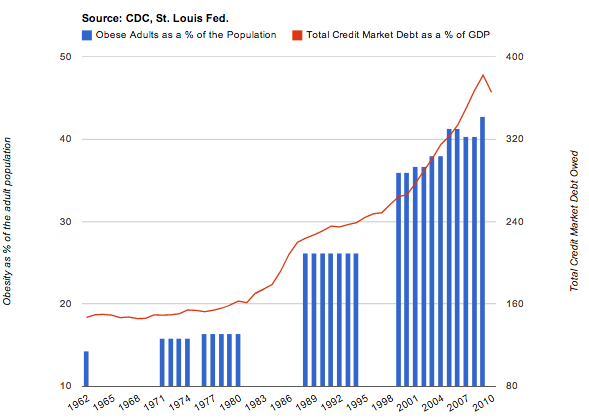The waistline bubble began to expand at just about the same time as the debt bubble:
First, it’s important emphasise that correlation is not causation — more than 99% of murderers have consumed water in the twenty four hour period preceding a murder. But it is clear that the effects of globalisation are at play in both cases (simply because globalisation has transformed the American economy) – far fewer Americans have to do physically demanding manufacturing work, and thanks to the mechanisation of agriculture and food production there are far more calories-per-American available to consume.
The interesting difference between debt and obesity is that while it is possible from historical evidence to construct a fairly coherent model linking excess outgrowth in debt with recession and depression — for example, I conjecture that a depression becomes inevitable when debt service cost growth consistently outpaces income growth — there is no such historical evidence available for obesity, because there has never in known world history been an obesity epidemic of such proportion, so there is no way to know how the obesity bubble may burst.
To what extent do the healthcare overheads of an obesity epidemic act as a drag on economic growth? According to an estimate by the CDC, $147 billion.
How much of a drag on the real economy is supporting those who have dropped out of the labour force due to obesity-related illness like diabetes, fatigue, depression and cardiovascular illness?
Well, we know that in the years that obesity has been exploding, that the disabled proportion of the workforce has almost tripled:
That’s almost 9 million individuals receiving Federal disability — almost six million more than we would have if the number of those receiving Federal disability was proportionate to the numbers at the beginning of the Ford administration. And if each disabled worker was contributing the per-capita average of $46,546 to GDP, the US would be producing roughly $279 billion more output.
Even if only half of the increase is associated with obesity (a very, very, very conservative estimate) that equates to around $140 billion of lost output. That — especially when considered next to the healthcare costs — is a pretty big gap, and that does not even begin to consider that the obese workers not on disability tend to be associated with lowered productivity.
So to what extent has the debt acquisition been an attempt to paper over the cracks of an economy increasingly losing productivity due to obesity and obesity-related illness, and to what extent is obesity linked to the current American employment and growth weakness?
Well, we know that it is possible to blow up a huge debt bubble without a high level of obesity, because Japan has been mired in a debt-fuelled depression for the last twenty years without any associated obesity epidemic, and because the Great Depression was preceded by a huge outgrowth in debt, but no such outgrowth in obesity. And certainly, the United States lives with far greater burdens than the effects of obesity — for example, the quantifiable burden of invading and occupying Iraq and Afghanistan has been greater in the past decade than the quantifiable burden of growing national obesity.
This is not to mention the effects of job migration, maintaining a global empire with bases in over 150 countries, and bailing out Wall Street banks. Debt has been a means to paper over the cracks of lost productivity and an American empire living far beyond the means of its productivity — but there is far more to that than just the outgrowth in obesity.
But obesity is causing a significant output loss, which by definition contributes to the wider problems.
- English (UK)
- English (India)
- English (Canada)
- English (Australia)
- English (South Africa)
- English (Philippines)
- English (Nigeria)
- Deutsch
- Español (España)
- Español (México)
- Français
- Italiano
- Nederlands
- Português (Portugal)
- Polski
- Português (Brasil)
- Русский
- Türkçe
- العربية
- Ελληνικά
- Svenska
- Suomi
- עברית
- 日本語
- 한국어
- 简体中文
- 繁體中文
- Bahasa Indonesia
- Bahasa Melayu
- ไทย
- Tiếng Việt
- हिंदी
Debt And Obesity In The United States
Published 10/24/2012, 06:17 AM
Updated 07/09/2023, 06:31 AM
Debt And Obesity In The United States
3rd party Ad. Not an offer or recommendation by Investing.com. See disclosure here or
remove ads
.
Latest comments
Install Our App
Risk Disclosure: Trading in financial instruments and/or cryptocurrencies involves high risks including the risk of losing some, or all, of your investment amount, and may not be suitable for all investors. Prices of cryptocurrencies are extremely volatile and may be affected by external factors such as financial, regulatory or political events. Trading on margin increases the financial risks.
Before deciding to trade in financial instrument or cryptocurrencies you should be fully informed of the risks and costs associated with trading the financial markets, carefully consider your investment objectives, level of experience, and risk appetite, and seek professional advice where needed.
Fusion Media would like to remind you that the data contained in this website is not necessarily real-time nor accurate. The data and prices on the website are not necessarily provided by any market or exchange, but may be provided by market makers, and so prices may not be accurate and may differ from the actual price at any given market, meaning prices are indicative and not appropriate for trading purposes. Fusion Media and any provider of the data contained in this website will not accept liability for any loss or damage as a result of your trading, or your reliance on the information contained within this website.
It is prohibited to use, store, reproduce, display, modify, transmit or distribute the data contained in this website without the explicit prior written permission of Fusion Media and/or the data provider. All intellectual property rights are reserved by the providers and/or the exchange providing the data contained in this website.
Fusion Media may be compensated by the advertisers that appear on the website, based on your interaction with the advertisements or advertisers.
Before deciding to trade in financial instrument or cryptocurrencies you should be fully informed of the risks and costs associated with trading the financial markets, carefully consider your investment objectives, level of experience, and risk appetite, and seek professional advice where needed.
Fusion Media would like to remind you that the data contained in this website is not necessarily real-time nor accurate. The data and prices on the website are not necessarily provided by any market or exchange, but may be provided by market makers, and so prices may not be accurate and may differ from the actual price at any given market, meaning prices are indicative and not appropriate for trading purposes. Fusion Media and any provider of the data contained in this website will not accept liability for any loss or damage as a result of your trading, or your reliance on the information contained within this website.
It is prohibited to use, store, reproduce, display, modify, transmit or distribute the data contained in this website without the explicit prior written permission of Fusion Media and/or the data provider. All intellectual property rights are reserved by the providers and/or the exchange providing the data contained in this website.
Fusion Media may be compensated by the advertisers that appear on the website, based on your interaction with the advertisements or advertisers.
© 2007-2024 - Fusion Media Limited. All Rights Reserved.
